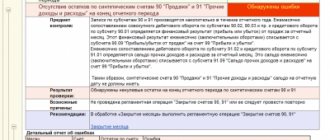Write-off of administrative and commercial expenses to cost price
Write-off of administrative and commercial expenses occurs through the 90th account as follows:
- Dt 90 subaccount “Administrative expenses” Kt 26;
- Dt 90 subaccount “Business expenses” Kt 44.
Let's dwell on the choice of method for writing off expenses from the 26th account.
An organization can choose and record in its accounting policy one of 2 methods of writing off to the following accounts:
- 20 (23, 29);
- 90.
With method 1, general business expenses participate in the formation of the full cost of finished products, ending up in cost accounts in full at the end of the month. They can be distributed between main, auxiliary and service industries, as well as between types of products. In the future, from the 20th (23rd, 29th) account, these expenses will go to the finished product accounts and will be written off in proportion to the volume of products sold to the cost price.
With the 2nd method, the financial result includes the entire amount of general business expenses incurred during the month, without being distributed between the products sold and those remaining in the warehouse. The 2nd method makes it much easier to write off expenses from the 26th account, and also increases expenses, reducing profits. The organization must describe the choice of method for writing off general business expenses in its accounting policy.
The chart of accounts does not allow you to choose which account to write off sales expenses to - only to the 90th one. However, the organization can choose whether to write them off completely or partially. Partial write-off implies a monthly distribution between goods sold and those remaining in the warehouse:
- for manufacturing companies - packaging and delivery costs;
- for trading companies - delivery costs.
Other items of selling expenses are written off in full.
Read about the distribution of delivery costs in the article “How to correctly calculate transport costs (nuances)?”
Account 90: subaccounts
The chart of accounts introduced the possibility of using the following elements of account 90:
- Account 90.1 is needed to reflect information on the cost measurement of income in the form of sales proceeds. Credit-type turnover on it is written off monthly, at the end of the period the balance is zero.
- Account 90.2 is used in accounting to record the cost of sales that were posted in accounting. Debit type turnover at the end of the month is written off, the subaccount has no balance. Entries are made using a cumulative method.
- Account 90.3 is intended to reflect the amount of VAT that must be received from the counterparty. Debit turnover accumulates during the month, and at the end of the period they are subject to write-off, the balance is reset to zero.
- Subaccounts 90 of accounts 90.4 and 90.5 are applied only if in the course of business activities it became necessary to record the amounts of excise taxes or export duties that were included in the price of goods sold by the enterprise.
Agricultural organizations use a different classification of subaccounts. For them, account 90.01 is needed to display the cost of sold crop products, shown by debit turnover. Credit turnover shows the value of revenue from the sale of this type of goods. In the agricultural sector, 90.02 is an accounting account for identifying the results of production and sales of livestock products. The debit indicates the cost of production, and the credit indicates sales revenue. Account 90, subaccount 3 in agriculture is intended to account for sales of industrial products and household goods.
For other types of goods and works the following subaccounts are provided:
- 90.4 for products from auxiliary and service industries;
- 90.5 for accounting for construction and installation types of work by specialized organizations when delivering finished objects to customers;
- 90.6 for the results of the sale of livestock and poultry that were received from individuals on a contractual basis;
- account 90.7 is needed to reflect the results of transactions related to the sale and transfer of housing to employees of the enterprise (farm); 90.07 – an account in which the actual cost of buildings (including outbuildings) is accumulated in debit turnover, and the estimated cost is shown on credit;
- account 90.08 is introduced to account for business transactions related to the sale of other types of goods that cannot be classified as other subaccounts.
Account 90.8, together with other sub-accounts, is closed at the end of the reporting period to display the financial result. In correspondence with them, account 90, subaccount 9, is involved. It is needed to determine profits or the amount of loss from sales made for the reporting period. After the balances from all sub-accounts are transferred by postings to account 90.09, the result can be written off by final correspondence to account 99. On the reporting date, the balance on account 90 will be zero.
Accounting for goods at sales prices
Organizations working with retail can keep records of goods at sales prices (clause 13 of PBU 5/01 “Accounting for inventories”, approved by order of the Ministry of Finance of the Russian Federation dated 06/09/2001 No. 44n). With this method there are some features of reflecting cost. Let's look at them with an example.
From 2021, PBU 5/01 will no longer be in force. To replace it, officials approved FSBU 5/2019 “Inventories,” which introduced a number of amendments to the procedure for accounting for goods. Get free demo access to K+ and go to the Ready Solution to learn all the nuances of inventory accounting according to the new standard.
Example
The store purchased 50 kg of one type of sweets at a price of 472 rubles. per kg, including VAT 20%. Goods are accounted for at sales prices. The selling price of sweets is 500 rubles. per kg. Let's assume that there were no leftovers of such candies at the beginning of the month.
Dt 41.1 Kt 60 - 20,000 rub. — sweets have arrived at purchase prices;
Dt 19 Kt 60 - 4,000 rub. — reflected incoming VAT;
Dt 41.2 Kt 41.1 — 20,000 rub. — candies sold at retail;
Dt 41.2 Kt 42 - 5,000 rub. (500 × 50 – 20,000) - reflects the trade margin.
Within a month, all the candies were sold:
Dt 50 Kt 90.1 - 25,000 rub. — revenue is reflected;
Dt 90.3 Kt 68 - 5,000 rub. — VAT is charged on the sale;
Dt 90.2 Kt 41.2 - 25,000 rub. — the cost of sweets is written off at sales prices;
Reversal Dt 90.2 Kt 42 - 5,000 rub. — the trade margin has been written off.
Check whether you are taking into account the financial result correctly, with the help of explanations from ConsultantPlus experts. If you do not have access to the K+ system, get a trial online access for free.
How to close reporting periods in accounting and determine financial results during the year
It is clear that this is an unusual and difficult task for beginners, so we will briefly and in an accessible form describe this process.
To determine the financial result of an organization’s activities, it is necessary to close the reporting period. In accounting, a month is recognized as a reporting period (clause 48 of PBU 4/99).
All accounts related to the display of production costs, revenue (income), and the formation of financial results for compiling the balance sheet of a small enterprise can be conditionally divided into three groups:
1 . Accounts that, in accordance with Order of the Ministry of Finance of the Russian Federation dated October 31, 2000 N 94n “On approval of the Chart of Accounts for accounting financial and economic activities of organizations and instructions for its application,” do not have a balance at the end of the month - 25 “General operating expenses” 26 “ General running costs".
2. Accounts that, in most cases, have a balance of work in progress, but can be completely closed (20 “Main production”, 23 “Auxiliary production”, 29 “Service production and facilities”)
3. Accounts that generally do not have a balance at the end of the month, but have a balance for each subaccount - 90 “Sales”, 91 “Other income and expenses”.
to menu
Determination of financial results for core activities
Postings to subaccounts of the 90th account are made throughout the year, accumulating the amounts of income and expenses. This approach makes it easy to generate the appropriate lines in the income statement. To obtain information about the organization's performance for the month, the accountant calculates expenses (turnover on the debit of the 90th account) and income (turnover on the credit of the 90th account). The difference between these values is profit or loss for the month; this value is reflected by posting Dt 90.9 Kt 99 when making a profit or Dt 99 Kt 90.9 when receiving a loss.
As a result, by the end of the year, a final balance will be formed on all subaccounts used by the organization, which must be reset to zero. For subaccounts with a debit balance, an entry for its full amount is made on the credit of this subaccount and the debit of subaccount 90.9, for subaccounts with a credit balance - vice versa:
Dt 90.1 Kt 90.9
Dt 90.9 Kt 90.2
Dt 90.9 Kt 90.3, etc.
Sales analysis is one of the main aspects that must be taken into account when developing an organization's marketing policy. Therefore, it is important to set up the correct analytics for account 90. Most often, sales analysis is carried out by type of product, by geographic location, by counterparty, by structural division of the organization, etc. Analytical accounting is organized depending on the needs of users for accounting information.
Subaccounts to account 90
To calculate the results of sales of products and provision of services with the calculation of profits and losses to account 90, in accordance with the accounting policy of the organization, additional sub-accounts are opened:
- 90.1 – to reflect revenue received in the company’s accounts;
- 90.2 – for accounting for production costs;
- 90.3 – to display the tax accrued on sales;
- 90.4 – for accounting for excise taxes included in the cost of goods;
- 90.5 – to display export duties paid;
- 90.7 – to account for expenses incurred during the sale;
- 90.8 – for fixing management expenses;
- 90.9 – if the month closes with a profit or turns out to be unprofitable.
Each subaccount accumulates a monthly balance, which is closed to zero at the end of the year.
Results
Account 90 is necessary to collect data on income and expenses for activities that the company considers normal for itself.
Income is recorded on the credit side of the account, and expenses are recorded on the debit side. The company can independently enter subaccounts to the 90th account - depending on business conditions and the accounting data used. You can find more complete information on the topic in ConsultantPlus. Free trial access to the system for 2 days.
Writing off costs to expense accounts
Write-off of expenses on account 26 “General business expenses”
The procedure for closing account 26 depends on the chosen accounting policy, or more precisely, the method of forming the cost of production.
The cost price can be formed: 1) at the full production cost; or 2) at reduced production costs.
Note: For small businesses, the second option is more convenient.
When choosing the accounting policy “at full production cost,” costs can be written off monthly by the following entries: Debit 20 “Main production” Credit 26 Debit 23 “Auxiliary production” Credit 26 Debit 29 “Servicing production and facilities” Credit 26
When choosing an accounting policy “at reduced production cost”, general business expenses can be fully attributed to cost:
D 90.2 “Cost of sales” Credit 26.
Write-off of expenses on account 25 “General production expenses”
Account 25 is closed monthly by debiting the amount of expenses from the account using the following transactions:
Debit 20 “Main production” Credit 25
Debit 23 “Auxiliary production” Credit 25
Debit 29 “Service production and facilities” Credit 25
depending on the activity with which these costs are associated.
Writing off costs from account 44 “Sales expenses”
Costs are written off from account 44 “Sales expenses” monthly in whole or in part by posting:
Debit 90.2 “Cost of sales” Credit 44 – sales expenses are written off.
Closing account 20 “Main production”, 23 “Auxiliary production”, 29 “Service production and facilities”
At the end of the month, accounts 20,23,29 can be closed with the following entries: Debit 90.2 “Cost of sales” Credit 20 Debit 90.2 “Cost of sales” Credit 23 Debit 90.2 “Cost of sales” Credit 29
Service organizations can close these accounts completely (without leaving unfinished production on the account balance).
to menu








